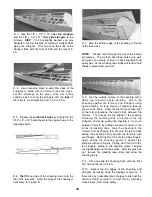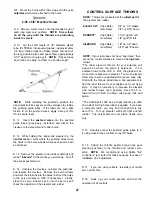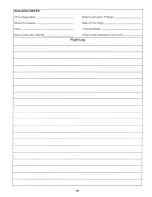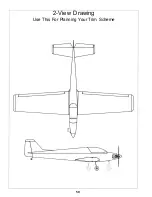
LANDING: When it's time to land, make your
approach low and shallow, as this ship wants to just
keep on flying (especially if built light) If you find that
it lands a little fast you might try dialing in a few clicks
of up elevator when you reduce the throttle on the
downwind leg of the landing approach This will
automatically help to bleed off some of the speed If
your ULTRA SPORT 1000 is built straight and true,
you'll find that you can really flare it out for slow, nose-
high, full-stall landings without fear of tip stalling.
Have a ball! But always stay in control and fly in a
safe manner.
GOOD LUCK AND GREAT FLYING!
CAUTION (THIS APPLIES TO ALL R/C AIR-
PLANES) If, while flying, you notice any unusual
sounds, such as a low-pitched "buzz", this may be an
indication of control surface "flutter" Because flutter
can quickly destroy components of your airplane, any
time you detect flutter you must immediately cut the
throttle and land the airplane' Check all servo grom
mets for deterioration (this will indicate which surface
fluttered), and make sure all pushrod linkages are
slop-free If it fluttered once, it will probably flutter
again under similar circumstances unless you can
eliminate the slop or flexing in the linkages Here are
some things which can result in flutter Excessive
hinge gap, Not mounting control horns solidly, Sloppy
fit of clevis pin in horn, Elasticity present in flexible
plastic pushrods, Side-play of pushrod in guide tube
caused by tight bends Sloppy fit of Z-bend in servo
arm, Insufficient glue used when gluing in the elevator
joiner wire or aileron torque rod, Excessive flexing of
aileron, caused by using too soft balsa aileron,
Excessive "play" or "backlash" in servo gears, and
Insecure servo mounting
SEE THE FULL LINE OF GREAT PLANES
AIRPLANES AT YOUR HOBBY DEALER
WE HOPE YOU WILL SELECT ANOTHER "GREAT
PLANE" AS YOUR NEXT PROJECT THANK YOU!
APPENDIX
FLIGHT TRIMMING
. . . A model is not a static object Unlike a car, which
can only hunt left or right on the road (technically, a car does yaw
in corners, and pitches when the brakes are applied), a plane
moves t h r o u g h t h a t f l u i d we c a l l air in a l l d i r e c t i o n s
simultaneously The plane may look l i k e it's going forward but it
could also be yawing slightly, slipping a little and simultaneously
climbing or diving a bit' The controls interact Yaw can be a
r u d d e r p r o b l e m a lateral balance problem or an aileron rigging
problem We must make m a n y f l i g h t s w i t h m i n o r changes
between each. to isolate and f i n a l l y correct the problem
The chart accompanying this article is intended to serve
as a handy field refference w h e n triming your model Laminate it
in plastic and keep it in y o u r flight box You just might h a v e need
to consult it at the next contest' The c h a r t is somewhat self-
explanatory, but we will briefly run through the salient points
First, we are assuming that the model has been C.G.
balanced according to the m a n u f a c t u r e r ' s directions There's
n o t h i n g sacred about that spot — f r a n k l y i t only r e f l e c t s the
balance point where a prototype model handled the w a y the guy
who designed it thought it should I f y o u r model's w i n g has a
degree more or less of incidence, then the whole balance formula
is incorrect for you But. it's a good ballpark place to start
The second a s s u m p t i o n is t h a t t h e model has been
balanced l a t e r a l l y Wrap a strong string of m o n o f i l a m e n t around
the prop shaft behind the spinner then tie the other end to the tail
wheel or to a screw driven into the bottom of the aft fuse Make
the string into a bridle harness and suspend the entire model
inverted (yes. w i t h the wing o n ' ) I f the right w i n g always drops,
sink some screws or lead into the l e f t wing tip, etc You may be
surprised to find out how much lead is needed
At this point the model is statically trimmed It's only a
starting point, so don't be surprised it you wind up changing it all.
One other critical feature is that the ailerons must h a v e their hinge
gap sealed I f shoving some Scotch tape or MonoKote into the
hinge gap to prevent the air from slipping f r o m the top of the wing
to the bottom, and vice-versa. bothers you. then don t do it
To achieve the maximum lateral trim on the model, the
hinge gap on the ailerons should be sealed The easiest way to do
this is to disconnect the aileron linkages and told the ailerons as
far over the top of the w i n g as possible (assuming they are top or
center hinged) Apply a strip of clear tape along the joint line.
When the aileron is returned to neutral, the tape will be invisible,
and the gap w i l l be e f f e c t i v e l y sealed Depending on how big the
ailerons are and how large a gaping gap you normally leave when
you install hinges you could experience a 20 percent increase in
aileron control response |ust by this simple measure
Your f i r s t f l i g h t s should be to ascertain control
centering and control feel Does the elevator always come back to
neutral after a 180 degree turn or Split-S? Do the ailerons tend to
hunt a little after a rolling maneuver? Put the plane through its
paces. Control centering is either a m e c h a n i c a l t h i n g ( b i n d i n g
servos, s t i f f l i n k a g e s etc ) an electronic t h i n g (bad servo
resolution or dead-band in the radio system), or C G (aft Center of
Gravity will make the plane wander a b i t ) The last possibility will
be obvious, but don t continue the testing u n t i l you have isolated
the problem and corrected it
let's get down to the task of trimming the model.
Use the tachometer every time you start the engine, to insure
consistent results These t r i m f l i g h t s m u s t he done in calm
weather Any wind w i l l only make the model w e a t h e r v a n e Each
"maneuver" on the list assumes that y o u w i l l enter it dead straight-
and-level The wings must be perfectly flat, or else the maneuver
will not be correct and you'll get a wrong interpretation That's
where your observer comes in I n s t r u c t him to be especially
watchful of the wings as you enter the maneuvers
Do all maneuvers at f u l l throttle The only deviation
from this is if the plane w i l l be routinely flown through maneuvers
at a different power setting
Let's commence with the "engine thrust angle" on the
chart Note that the observations you make can also he caused by
the C G so be prepared to change both to see w h i c h gives the
desired result Set up a straight and-level pass The model should
53
Содержание Ultra-Sport 1000
Страница 7: ...7 DIE PATTERNS Use This Drawing To Identify Die Cut Parts...
Страница 57: ...57...
Страница 59: ...2 View Drawing Use This For Planning Your Trim Scheme 59...







































